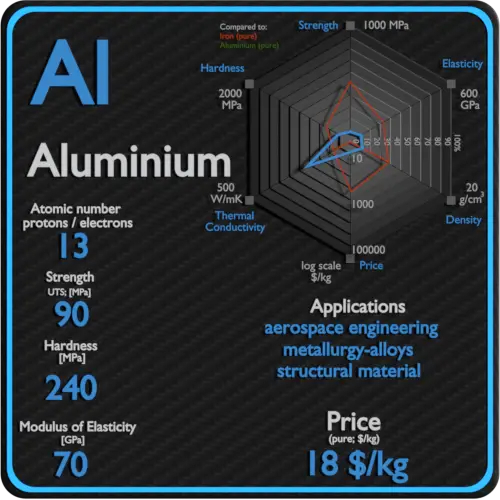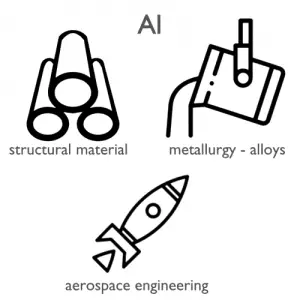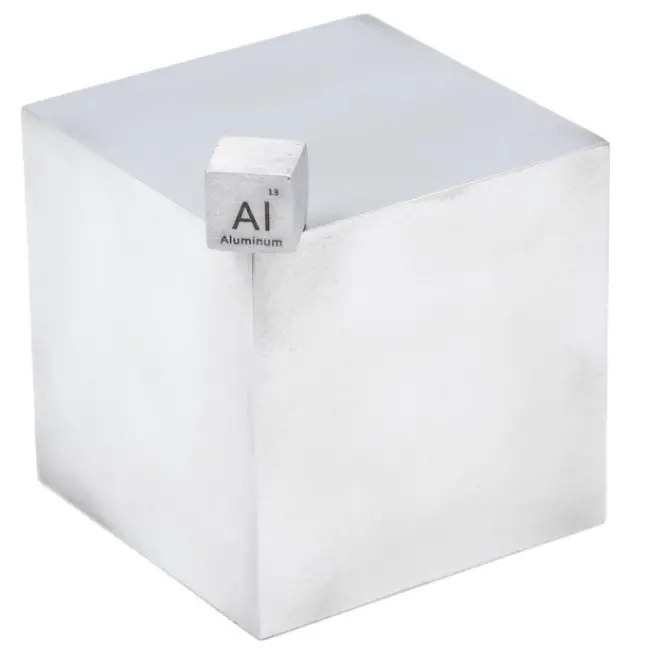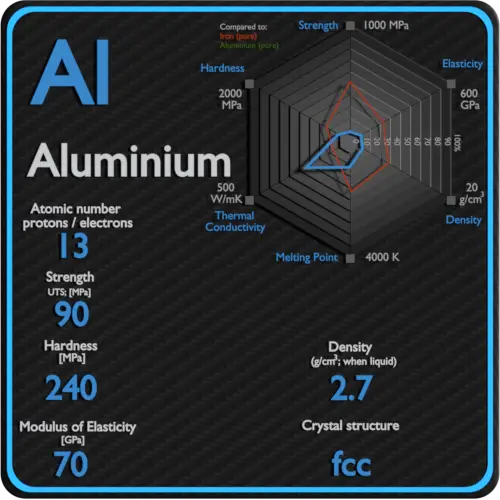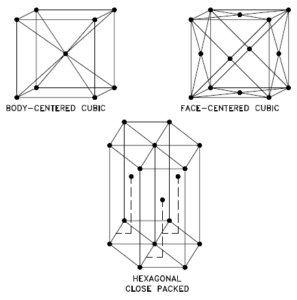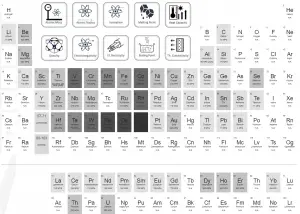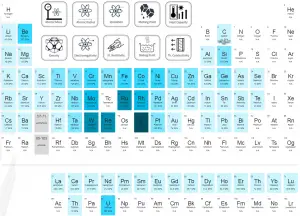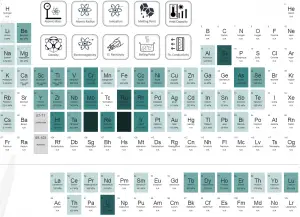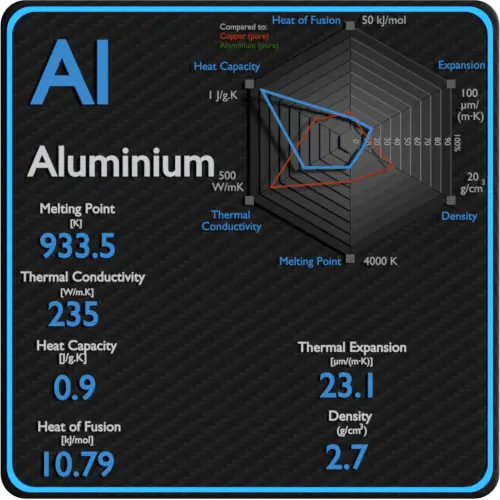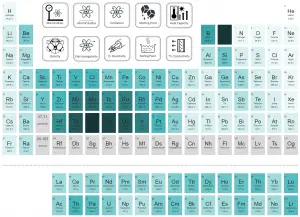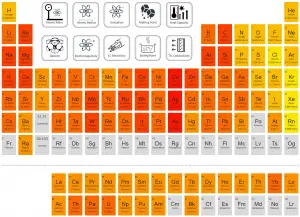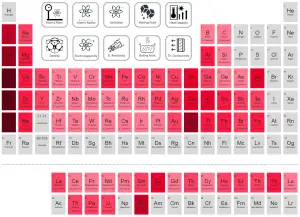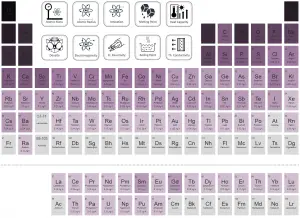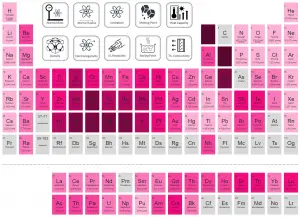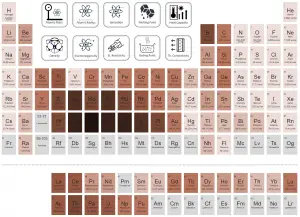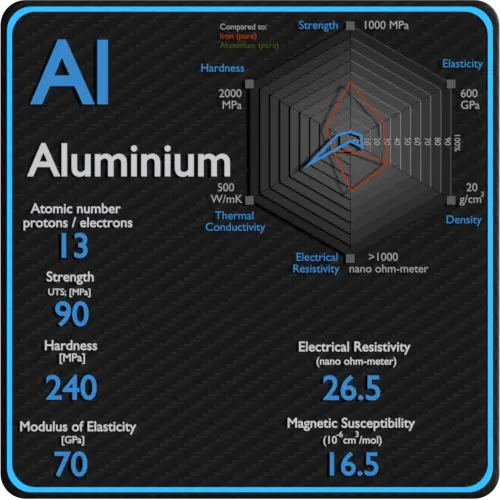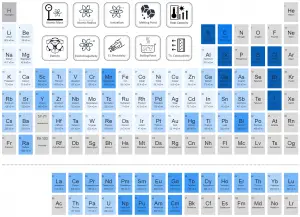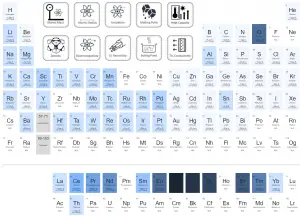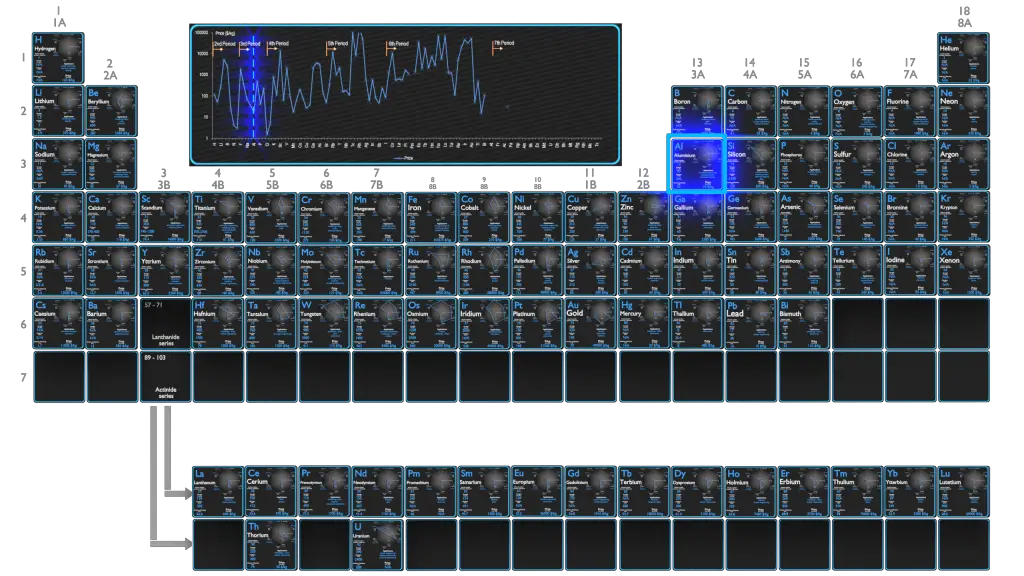About Aluminium
Aluminium is a silvery-white, soft, nonmagnetic, ductile metal in the boron group. By mass, aluminium makes up about 8% of the Earth’s crust; it is the third most abundant element after oxygen and silicon and the most abundant metal in the crust, though it is less common in the mantle below.
Summary
| Element | Aluminium |
| Atomic number | 13 |
| Element category | Poor Metal |
| Phase at STP | Solid |
| Density | 2.7 g/cm3 |
| Ultimate Tensile Strength | 90 MPa (pure), 600 MPa (alloys) |
| Yield Strength | 11 MPa (pure), 400 MPa (alloys) |
| Young’s Modulus of Elasticity | 70 GPa |
| Mohs Scale | 2.8 |
| Brinell Hardness | 240 MPa |
| Vickers Hardness | 167 MPa |
| Melting Point | 660 °C |
| Boiling Point | 2467 °C |
| Thermal Conductivity | 237 W/mK |
| Thermal Expansion Coefficient | 23.1 µm/mK |
| Specific Heat | 0.9 J/g K |
| Heat of Fusion | 10.79 kJ/mol |
| Heat of Vaporization | 293.4 kJ/mol |
| Electrical resistivity [nanoOhm meter] | 26.5 |
| Magnetic Susceptibility | +16.5e-6 cm^3/mol |
Applications of Aluminium
Aluminium and its alloys are used widely in aerospace, automotive, architectural, lithographic, packaging, electrical and electronic applications. It is the prime material of construction for the aircraft industry throughout most of its history. About 70% of commercial civil aircraft airframes are made from aluminium alloys, and without aluminium civil aviation would not be economically viable. Automotive industry now includes aluminium as engine castings, wheels, radiators and increasingly as body parts. 6111 aluminium and 2008 aluminium alloy are extensively used for external automotive body panels. Cylinder blocks and crankcases are often cast made of aluminium alloys.
Production and Price of Aluminium
Raw materials prices change daily. They are primarily driven by supply, demand and energy prices. In 2019, prices of pure Aluminium were at around 18 $/kg.
Aluminium is extracted from the principal ore, bauxite. Significant bauxite deposits are found throughout Australia, the Caribbean, Africa, China and South America. Open cut techniques are commonly used to mine the bauxite. The bauxite is purified using the Bayer process. Aluminium production is highly energy-consuming, and so the producers tend to locate smelters in places where electric power is both plentiful and inexpensive. As of 2012, the world’s largest smelters of aluminium are located in China, Russia, Bahrain, United Arab Emirates, and South Africa.
Source: www.luciteria.com
Mechanical Properties of Aluminium
Strength of Aluminium
In mechanics of materials, the strength of a material is its ability to withstand an applied load without failure or plastic deformation. Strength of materials basically considers the relationship between the external loads applied to a material and the resulting deformation or change in material dimensions. In designing structures and machines, it is important to consider these factors, in order that the material selected will have adequate strength to resist applied loads or forces and retain its original shape. Strength of a material is its ability to withstand this applied load without failure or plastic deformation.
For tensile stress, the capacity of a material or structure to withstand loads tending to elongate is known as ultimate tensile strength (UTS). Yield strength or yield stress is the material property defined as the stress at which a material begins to deform plastically whereas yield point is the point where nonlinear (elastic + plastic) deformation begins.
See also: Strength of Materials
Ultimate Tensile Strength of Aluminium
Ultimate tensile strength of Aluminium is 90 MPa (pure), 600 MPa (alloys).
Yield Strength of Aluminium
Yield strength of Aluminium is 11 MPa (pure), 400 MPa (alloys).
Modulus of Elasticity of Aluminium
The Young’s modulus of elasticity of Aluminium is 70 GPa.
Hardness of Aluminium
In materials science, hardness is the ability to withstand surface indentation (localized plastic deformation) and scratching. Brinell hardness test is one of indentation hardness tests, that has been developed for hardness testing. In Brinell tests, a hard, spherical indenter is forced under a specific load into the surface of the metal to be tested.
Brinell hardness of Aluminium is approximately 240 MPa.
The Vickers hardness test method was developed by Robert L. Smith and George E. Sandland at Vickers Ltd as an alternative to the Brinell method to measure the hardness of materials. The Vickers hardness test method can be also used as a microhardness test method, which is mostly used for small parts, thin sections, or case depth work.
Vickers hardness of Aluminium is approximately 167 MPa.
Scratch hardness is the measure of how resistant a sample is to permanent plastic deformation due to friction from a sharp object. The most common scale for this qualitative test is Mohs scale, which is used in mineralogy. The Mohs scale of mineral hardness is based on the ability of one natural sample of mineral to scratch another mineral visibly.
Aluminium is has a hardness of approximately 2.8.
See also: Hardness of Materials
Aluminium – Crystal Structure
A possible crystal structure of Aluminium is face-centered cubic structure.
In metals, and in many other solids, the atoms are arranged in regular arrays called crystals. A crystal lattice is a repeating pattern of mathematical points that extends throughout space. The forces of chemical bonding causes this repetition. It is this repeated pattern which control properties like strength, ductility, density, conductivity (property of conducting or transmitting heat, electricity, etc.), and shape. There are 14 general types of such patterns known as Bravais lattices.
See also: Crystal Structure of Materials
Crystal Structure of Aluminium

Thermal Properties of Aluminium
Aluminium – Melting Point and Boiling Point
Melting point of Aluminium is 660°C.
Boiling point of Aluminium is 2467°C.
Note that, these points are associated with the standard atmospheric pressure.
Aluminium – Thermal Conductivity
Thermal conductivity of Aluminium is 237 W/(m·K).
The heat transfer characteristics of a solid material are measured by a property called the thermal conductivity, k (or λ), measured in W/m.K. It is a measure of a substance’s ability to transfer heat through a material by conduction. Note that Fourier’s law applies for all matter, regardless of its state (solid, liquid, or gas), therefore, it is also defined for liquids and gases.
Coefficient of Thermal Expansion of Aluminium
Linear thermal expansion coefficient of Aluminium is 23.1 µm/(m·K)
Thermal expansion is generally the tendency of matter to change its dimensions in response to a change in temperature. It is usually expressed as a fractional change in length or volume per unit temperature change.
Aluminium – Specific Heat, Latent Heat of Fusion, Latent Heat of Vaporization
Specific heat of Aluminium is 0.9 J/g K.
Heat capacity is an extensive property of matter, meaning it is proportional to the size of the system. Heat capacity C has the unit of energy per degree or energy per kelvin. When expressing the same phenomenon as an intensive property, the heat capacity is divided by the amount of substance, mass, or volume, thus the quantity is independent of the size or extent of the sample.
Latent Heat of Fusion of Aluminium is 10.79 kJ/mol.
Latent Heat of Vaporization of Aluminium is 293.4 kJ/mol.
Latent heat is the amount of heat added to or removed from a substance to produce a change in phase. This energy breaks down the intermolecular attractive forces, and also must provide the energy necessary to expand the gas (the pΔV work). When latent heat is added, no temperature change occurs. The enthalpy of vaporization is a function of the pressure at which that transformation takes place.
Aluminium – Electrical Resistivity – Magnetic Susceptibility
Electrical property refers to the response of a material to an applied electric field. One of the principal characteristics of materials is their ability (or lack of ability) to conduct electrical current. Indeed, materials are classified by this property, that is, they are divided into conductors, semiconductors, and nonconductors.
See also: Electrical Properties
Magnetic property refers to the response of a material to an applied magnetic field. The macroscopic magnetic properties of a material are a consequence of interactions between an external magnetic field and the magnetic dipole moments of the constituent atoms. Different materials react to the application of magnetic field differently.
See also: Magnetic Properties
Electrical Resistivity of Aluminium
Electrical resistivity of Aluminium is 26.5 nΩ⋅m.
Electrical conductivity and its converse, electrical resistivity, is a fundamental property of a material that quantifies how Aluminium conducts the flow of electric current. Electrical conductivity or specific conductance is the reciprocal of electrical resistivity.
Magnetic Susceptibility of Aluminium
Magnetic susceptibility of Aluminium is +16.5e-6 cm^3/mol.
In electromagnetism, magnetic susceptibility is the measure of the magnetization of a substance. Magnetic susceptibility is a dimensionless proportionality factor that indicates the degree of magnetization of Aluminium in response to an applied magnetic field.
